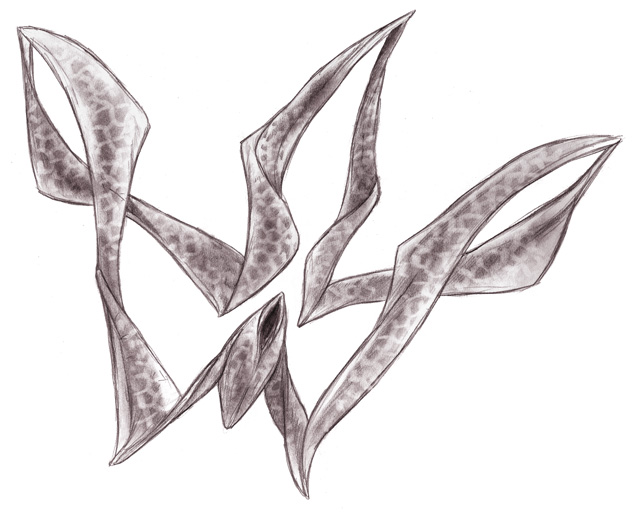Order Arcophylla was predictably straightforward, since it
was a basic design I had since I first began work with nereophytes, and the
Gemellocaputids more so; golden bowstalk is the quintessential genus of
this family. I had always imagined these
plants sprawling over hills and valleys, the nereid equivalent of grass, and
wanted to depict them as such. I think
the image captures that, and I’m pleased with how it finally turned out. As with many of these images, where several
organisms are present in the frame, there is a great deal of duplication taking
place. I think I’ve done a good job
hiding it from all but the most discerning eyes.
I included the fen bowstalk for two reasons: first,
to indicate variety among the nereophytes, as well as to exercise my creativity
in varying the biological theme; second, to illustrate the breadth of the
taxonomic family’s influence. It took
some thinking to figure out exactly how this branch of the bowstalk family tree
would differ from the golden breeds, but I think I succeeded. It was a bit of a challenge to determine
exactly how these plants would differ from their cousins, but as I looked at
how different grasses of Earth vary, especially those in swampy areas, design
ideas soon came to mind: shorter, more succulent stalks, and darker coloration
that could be just a cosmetic difference or could reflect differing
photosynthetic needs.
The hourglass tree was my first attempt at taking the
Arcophylla bauplan to arboreal scales, and an attempt to take the concept of
“reef building” out of the ocean. There
may be some biological kinks to work out of the system, but I’m satisfied with
the results at this point. As far as the
picture goes, I wonder if I’ve sufficiently captured the glassy nature of the
trunks. I also considered showing what
one of the dead trunks looks like when it has collapsed under its own weight,
in order to show more of the nereophyte’s life cycle, but as always time is a
prohibitive factor. Perhaps your
imagination can fill in those details.
The lingayoni is one of the Barbitids, a family that caused
me to do some taxonomic revision as I began to finalize their designs. Originally, this plant would be the only
featured member of a more primitive branch of Arcophylla, neither Gemellocaputid
nor Barbitid, but once I realized that the other Barbitids didn’t vary greatly
in their respective bauplans, it was clear that some changes needed to be
made. Some of you who were following the
site at that time may have noticed some mysterious shuffling around that was a
result of those adjustments.
But it was the harpweed that most influenced the
design of the Barbitids. I had a clear
image of them in my mind since their inception.
I admit that there may still be some biomechanical considerations to
work out, especially when it comes to the egressor tissues and how they serve
this design, but at the very least I have the basic ideas down for others to
examine. I consider a lot of these
plants a bit of a first draft anyway, and welcome feedback as always.
One of my first real challenges of this batch was the treebuchet;
when I first started writing about it on the savanna biome page I had no real concept
of its appearance, and placed a sort of “place holder” that roughly
approximated how I thought it would ultimately look. But as I began work on this plant in earnest,
I didn’t want to draw a tree that was little more than a scaled up version of
its cousins. So while the treebuchet still
fits within the Barbitid bauplan, it seems different enough to accomplish the
diversity I want to see in the project.
Moving on from Arcophylla, it was the Myomotia that caused
me some real pause in my research and designs.
I had always intended for the newel tree to be different from the
others of the clade, but as I visualized it growing from the base of the trunk
upwards (a trait very different from Earth plants, but quite common in Nereid clades)
I began to wonder where its reproductive structures are located. In keeping with the nereophytes from which it
derived, the central stalk corresponds to the photosynthetic stalk of the
Barbitids and similarly evolved structures, but that fact seems to imply that
the newel tree’s reproductive organs are located near the base of the tree and
not at the tip, as evidenced in the other Myomotes. This hardly seems an effective placement, and
I’m having difficulty resolving the issue; any feedback or insight here would
be especially appreciated.
Flaywood starts to stretch into some of the extremes
of plausibility, I think. After reading
the plant’s description it’s possible that the reader might interpret that
these vines are constantly writhing and twisting; I imagine them to be much
less active than that, laying motionless for the most part until stimulated, like
traps to be sprung by hapless savanna nereids.
There may still be more fiction than fact in the flaywood, but I’d like
to explore them further before dismissing their inclusion entirely.
The final nereophyte of this batch is also the one I most
looked forward to, as it’s one of the few additions that provide the conceptual
basis for an entire biome. The coryphee
is the “prima ballerina” of the ballerina forests, the nereophyte that gave
xenobotanists the impression of graceful dancers. It’s quite different from the types of plants
that are found in similar climates on Earth, which makes it satisfactorily
alien, but hopefully not so much so that it too strains credulity.
As always, I welcome thoughtful feedback or insights that
can help me develop my work on this project further. You can either do so here in the comments
section or at the appropriate thread in the Speculative Evolution forums.





